Safety Board
-
- Unauthorized W e l d i n g Caused Carnival Ecstasy Fire Maritime Reporter, May 2001 #17
Unauthorized welding on laundry room equipment triggered a fire aboard the cruise ship Ecstasy off Miami in 1998, injuring 22 people and causing more than $17 million in damages, U.S.
safety investigators concluded.
The National Transportation Safety Board (NTSB) said that sparks from the welding equipment caused a fire that quickly spread and ignited a large accumulation of lint in the laundry room ventilation ducts. The fire migrated through that system to the aft mooring deck where it fed on dock lines, generating such intense heat that it knocked out an electrical system that helped power the ship's engines.
Ecstasy, with 2,565 passengers and 916 crew, was left adrift several miles east of Miami before rescue crews put out the fire and towed the ship back to port. Sprinkler systems activated by heat and smoke prevented the fire from spreading to upper decks and other areas of the ship, the safety board found.
However, the board concluded that the lack of a fire suppression system on the mooring deck enabled the fire to rage.
Investigators largely praised the crew for its handling of the emergency, but noted shortfalls in procedures for distributing life jackets and accounting for passengers during an emergency.
In its recommendations, the board said Carnival should change its procedures to prevent any unauthorized welding or work that could cause a fire and revise information on safety procedures during emergencies. Crews working on the laundry equipment aboard the Ecstasy failed to obtain the necessary permit to do the work, investigators found.
The board also recommended that the company inspect, and, if necessary, modify electrical circuits to ensure that a single failure could not disable a ship's propulsion system. They also recommended that the cruise ship industry should ensure that fire suppression systems were placed on the mooring decks if they carried equipment in that area of the ship that could burn, and suggested the ships should have emergency call systems in staterooms and crew cabins so people trapped during a fire could at least signal their location.
-
- SNAME Chesapeake Section Hears Landing Craft And Steering Gear Papers Maritime Reporter, Aug 1981 #10
, Naval Sea Systems Command ; secretarytreasurer, Alex Landsburg, Maritime Administration; Elected Member, Ralph Johnson, National Transportation Safety Board. There being no nominations from the floor, the slate as presented was elected unanimously. Outgoing chairman Robert Scott was presented with
-
- New Risks Moving Crude Oil by Rail Marine News, Sep 2015 #28
concerns about safety. The July 2013 crude oil train accident in Lac-Mégantic, Quebec, Canada, which resulted in 47 fatalities (Transportation Safety Board of Canada, 2014) has caused significant concern about the safety of crude-by-rail (CBR) transportation of very volatile Bakken crude in particular
-
- Insights: USCG Can Suspend and Revoke Merchant Mariner Credentials Maritime Logistics Professional, Q3 2016 #12
can appeal that decision and order to the Commandant of the Coast Guard. The Commandant’s decision may be appealed to the National Transportation Safety Board. The Board’s decision can be appealed to the appropriate U.S. Circuit Court of Appeals and ultimately to the Supreme Court of the United States
-
- ICCL Addressed Safety, ADA Features Of Cruise Ships Maritime Reporter, Aug 2000 #61
The International Council of Cruise Lines (ICCL) attended the meeting of the National Transportation Safety Board (NTSB) on July 11 where the Board discussed a safety recommendation issued to the cruise industry in 1997. The Board thoroughly criticized the industry for not imminently installing the
-
- MSI/CAORF Trains How To Avoid Ship Accidents Before They Happen Maritime Reporter, Dec 1989 #49
alone at the CAORF facility is worth over $20 million). The CAORF facility is so unique that both the Coast Guard and the National Transportation Safety Board have contracted to study the Valdez accident 5,000 miles away from the point of its occurrence —at MSI/CAORF. Simulation technology combined with
-
- New Lifesaving Equipment Rules Proposed For Large Commercial Ships Maritime Reporter, Jun 1989 #98
also carry out a number of recommendations that resulted from marine casualty investigations by the Coast Guard and the National Transportation Safety Board. Lifesaving equipment regulations for Great Lakes ships and other ships in domestic trade that are not covered by SOLAS would also be revised
-
- Anatomy of a Marine Casualty Investigation Maritime Reporter, Jan 2020 #24
when a significant marine casualty occurs.First, it is important to note that although not required, it is not unusual for the National Transportation Safety Board (NTSB) and the United States Coast Guard (USCG) to coordinate, in part, their efforts to investigate and establish the root cause of a marine casualty
-
- Anatomy of a Marine Casualty Investigation Maritime Reporter, Jan 2020 #24
when a significant marine casualty occurs.First, it is important to note that although not required, it is not unusual for the National Transportation Safety Board (NTSB) and the United States Coast Guard (USCG) to coordinate, in part, their efforts to investigate and establish the root cause of a marine casualty
-
- Aegis Cruiser "Valley Forge' Christened At Ingalls Shipyard Maritime Reporter, Nov 1984 #33
, smashing the traditional bottle of champagne across the bow. Patricia Goldman of Washington, D.C., vice chairman of the National Transportation Safety Board, was matron of honor. Vice Adm. Harry C. Schrader Jr., USN, Commander of the U.S. Pacific Fleet's Surface Force, which Valley Forge will join
-
- SNAME And SSC Plan Ship Vibration Symposium For Washington, D.C. October 1978 Maritime Reporter, Nov 15, 1977 #47
Corporation, and Jacques B. Hadler, David W. Taylor Naval Ship Research and Development Center. Ralph Johnson, National Transportation Safety Board and Dr. Warren C. Dietz, U.S. Coast Guard, will serve as co-chairmen of the Arrangements Committee. Lt. Comdr. Thomas H. Robinson, U.S. Coast
-
- Safety: It's All About Culture Marine News, Sep 2014 #18
mitigating risk. PVA’s proactive efforts in creating Flagship have been recently acknowledged by the former Chairman of the National Transportation Safety Board (NTSB) Deborah Hersman. At a recent public Board meeting Chairman Hersman stated, “We have very often seen industry leadership actually surpass
-
 )
March 2024 - Marine Technology Reporter page: 43
)
March 2024 - Marine Technology Reporter page: 43Image courtesy Kongsberg Discovery Image courtesy Teledyne Marine New Products Teledyne Marine had its traditional mega-booth at Oi, busy start to ? nish. Image courtesy Greg Trauthwein offers quality sub-bottom pro? ling capability without the need tion of offshore windfarms. GeoPulse 2 introduces new
-
 )
March 2024 - Marine Technology Reporter page: 38
)
March 2024 - Marine Technology Reporter page: 38CBA and the batteries being tested, providing automatic sens- ies you have. Universal smart chargers are pre-programmed ing of the battery cell count, a safety check of the test rate, and for the correct charging pro? le for the different battery fami- recommendation of a minimum safe discharge voltage. lies
-
 )
March 2024 - Marine Technology Reporter page: 25
)
March 2024 - Marine Technology Reporter page: 25Auerbach explained that ideally, “one ? ed layers of geothermal activity,” noted changes over an area of 8,000 km2. They would have both instruments: seismom- Skett, “and the change in salinity and dis- found up to seven km3 of displaced ma- eters to detect and locate subsurface ac- solved particles for
-
 )
March 2024 - Marine Technology Reporter page: 17
)
March 2024 - Marine Technology Reporter page: 17• Integrity assessment, and otherwise covered, e.g., by rock dump. As for depletion of • Mitigation, intervention and repair. sacri? cial anodes, this can be dif? cult or even impossible to Selecting the best method for collecting the data these work- estimate due to poor visibility, the presence of
-
 )
March 2024 - Marine Technology Reporter page: 15
)
March 2024 - Marine Technology Reporter page: 15sensor options for longer mission periods. About the Author For glider users working in ? sheries and conservation, Shea Quinn is the Product Line Manager the Sentinel can run several high-energy passive and active of the Slocum Glider at Teledyne Webb acoustic sensors, on-board processing, and imaging
-
 )
March 2024 - Marine Technology Reporter page: 14
)
March 2024 - Marine Technology Reporter page: 14TECH FEATURE TELEDYNE SLOCUM GLIDERS to hold over 3.5 times as many lithium primary batteries as the the water column and its thrusters give it the ability to stay standard Slocum Glider, and to physically accommodate up to on track in strong currents or other dif? cult ocean condi- 8 different sensor
-
 )
March 2024 - Marine Technology Reporter page: 11
)
March 2024 - Marine Technology Reporter page: 11, including thousands of World War II-era unexploded mines and artillery shells. Post-con? ict mine clearance in the Black Sea will be critical to the safety and security of regional maritime opera- tions. But this will be neither quick nor easy given the volume of mine-like ob- jects scattered across
-
 )
March 2024 - Marine Technology Reporter page: 6
)
March 2024 - Marine Technology Reporter page: 6MTR Editorial Advisors Gallaudet Hardy The Honorable Tim Gallaudet, Kevin Hardy is President PhD, Rear Admiral, U.S. of Global Ocean Design, Navy (ret) is the CEO of creating components and Ocean STL Consulting and subsystems for unmanned host of The American Blue vehicles, following a career
-
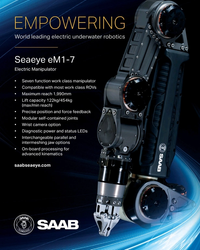 )
March 2024 - Marine Technology Reporter page: 3
)
March 2024 - Marine Technology Reporter page: 3EMPOWERING World leading electric underwater robotics Seaeye eM1-7 Electric Manipulator • Seven function work class manipulator • Compatible with most work class ROVs • Maximum reach 1,990mm • Lift capacity 122kg/454kg (max/min reach) • Precise position and force feedback • Modular self-contained
-
 )
March 2024 - Marine Technology Reporter page: 2
)
March 2024 - Marine Technology Reporter page: 2March/April 2024 On the Cover Volume 67 • Number 3 Image courtesy NIWA-Nippon Foundation TESMaP / Rebekah Parsons-King 8 Subsea Defense Black Sea Mines When the shooting stops in the Ukraine, the tough work of clearing mines will commence. By David Strachan 12 Gliders Slocum Sentinel 22 Teledyne
-
 )
April 2024 - Maritime Reporter and Engineering News page: 43
)
April 2024 - Maritime Reporter and Engineering News page: 43“The industry is an ecosystem which includes owners, managers, mariners, shipyards, equipment makers, designers, research institutes and class societies: all of them are crucial,” – Eero Lehtovaara, Head of Regulatory & Public Affairs, ABB Marine & Ports All images courtesy ABB Marine and Ports provi
-
 )
April 2024 - Maritime Reporter and Engineering News page: 42
)
April 2024 - Maritime Reporter and Engineering News page: 42can ? nd that one overrides the other in an unique - role in the maritime industry going to happen, it must also become unexpected way, compromising safety. over recent years, as a ‘stakeholder’ si- more ef? cient very quickly to meet the “In SOLAS, every ship system is con- multaneously mindful of
-
 )
April 2024 - Maritime Reporter and Engineering News page: 41
)
April 2024 - Maritime Reporter and Engineering News page: 41that could ease the investigative work re- better decision-making comes improved use of digital shipping technology, com- quired for concluding claims. safety. Improved safety in turn helps to bined with a global shortage of experi- It can also help shipping companies increase crew welfare. enced of? cers
-
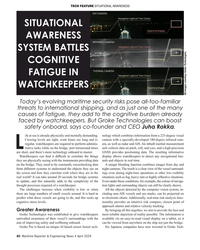 )
April 2024 - Maritime Reporter and Engineering News page: 40
)
April 2024 - Maritime Reporter and Engineering News page: 40, and as just one of the many causes of fatigue, they add to the cognitive burden already faced by watchkeepers. But Groke Technologies can boost safety onboard, says co-founder and CEO Juha Rokka. ife at sea is already physically and mentally demanding. nology which combines information from a 225-degree
-
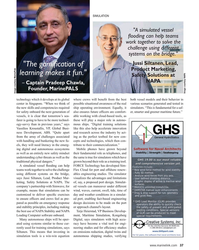 )
April 2024 - Maritime Reporter and Engineering News page: 37
)
April 2024 - Maritime Reporter and Engineering News page: 37solve the challenge using different systems on the bridge." – Jussi Siltanen, Lead, "The gami? cation of Product Marketing, learning makes it fun." Safety Solutions at NAPA – Captain Pradeep Chawla, Founder, MarinePALS Image courtesy MarinePals Image courtesy NAPA technology which it develops at its
-
 )
April 2024 - Maritime Reporter and Engineering News page: 35
)
April 2024 - Maritime Reporter and Engineering News page: 35in a variety of short weather and sea conditions, aiming to improve the advanced and entertaining ways. MarinePALS is therefore embracing a navigational safety skills required for CTV ship handling. new approach that involves interactive experiences and bite- Simulators are becoming as interconnected as onboard
-
 )
April 2024 - Maritime Reporter and Engineering News page: 25
)
April 2024 - Maritime Reporter and Engineering News page: 25RADM PHILIP SOBECK, MILITARY SEALIFT COMMAND Photo by Brian Suriani USN Military Sealift Command From a global supply chain perspective, What makes MSC so vital to the we’ve learned a lot about dealing with Navy’s ? eet and our military disruptions. COVID delivered a big forces around the world? wake-up
-
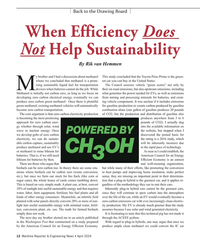 )
April 2024 - Maritime Reporter and Engineering News page: 12
)
April 2024 - Maritime Reporter and Engineering News page: 12Back to the Drawing Board When Efficiency Does Not Help Sustainability By Rik van Hemmen y brother and I had a discussion about methanol This study concluded that the Toyota Prius Prime is the green- where we concluded that methanol is a prom- est car you can buy in the United States. ising sustainable
-
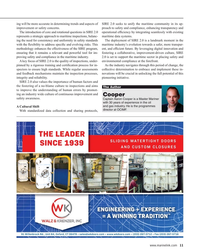 )
April 2024 - Maritime Reporter and Engineering News page: 11
)
April 2024 - Maritime Reporter and Engineering News page: 11ing will be more accurate in determining trends and aspects of SIRE 2.0 seeks to unify the maritime community in its ap- improvement or safety concerns. proach to safety and compliance, enhancing transparency and The introduction of core and rotational questions in SIRE 2.0 operational ef? ciency by
-
 )
April 2024 - Maritime Reporter and Engineering News page: 10
)
April 2024 - Maritime Reporter and Engineering News page: 10Maritime Safety © Roman/AdobeStock SIRE 2.0: Navigating the New Horizon of Maritime Safety By Captain Aaron Cooper, Programs Director, OCIMF he maritime industry is on the cusp of a signi? cant preparing vessel operators and vessel assurance teams for the transformation with the launch of the Ship
-
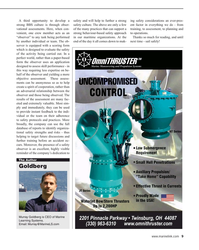 )
April 2024 - Maritime Reporter and Engineering News page: 9
)
April 2024 - Maritime Reporter and Engineering News page: 9A third opportunity to develop a safety and will help to further a strong ing safety considerations an ever-pres- strong BBS culture is through obser- safety culture. The above are only a few ent factor in everything we do - from vational assessments. Here, when con- of the many practices that can
-
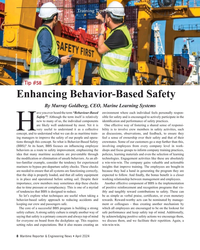 )
April 2024 - Maritime Reporter and Engineering News page: 8
)
April 2024 - Maritime Reporter and Engineering News page: 8Training Tips for Ships © By tuastockphoto/AdobeStock Tip #58 Enhancing Behavior-Based Safety By Murray Goldberg, CEO, Marine Learning Systems ave you ever heard the term “Behaviour-Based environment where each individual feels personally respon- Safety”? Although the term itself is relatively sible for
-
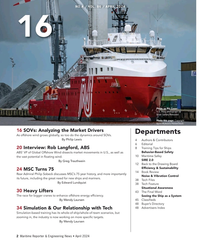 )
April 2024 - Maritime Reporter and Engineering News page: 2
)
April 2024 - Maritime Reporter and Engineering News page: 2the dynamics around SOVs. By Philip Lewis 4 Authors & Contributors 6 Editorial 8 Training Tips for Ships 20 Interview: Rob Langford, ABS Behavior-Based Safety ABS’ VP of Global Offshore Wind dissects market movements in U.S., as well as 10 Maritime Safey the vast potential in ? oating wind. SIRE 2.0 By
-
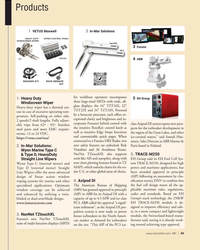 )
April 2024 - Marine News page: 43
)
April 2024 - Marine News page: 43. When ice-covered waters,” said Samuli Hän- https://vetus.com/usa/ connected to a Furuno DRS Radar, two ninen, Sales Director at ABB Marine & new safety features are unlocked: Risk Ports based in Finland. 2. In-Mar Solutions: Visualizer and AI Avoidance Route. Wynn Marine Type C NavNet TZtouchXL
